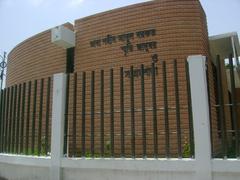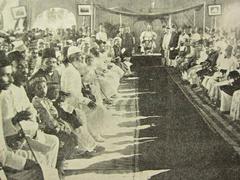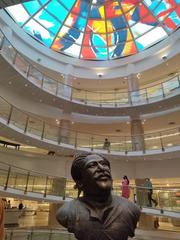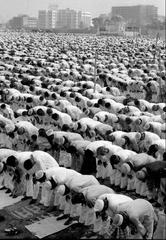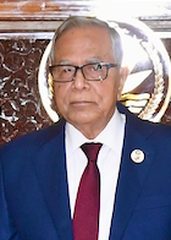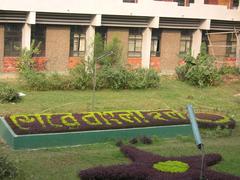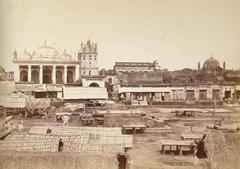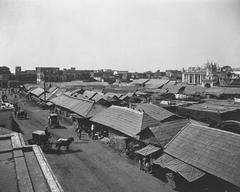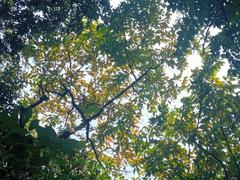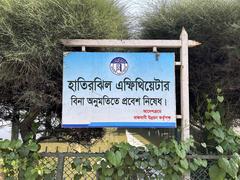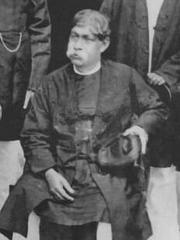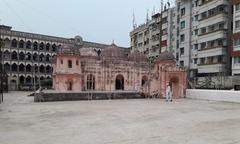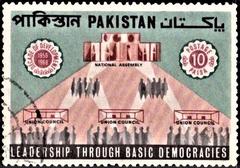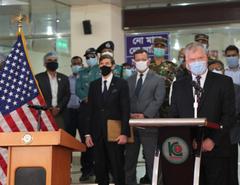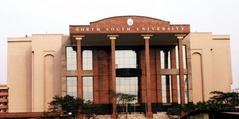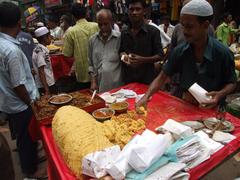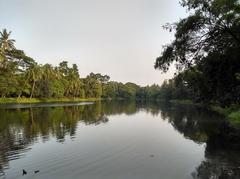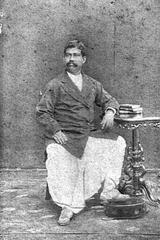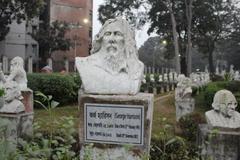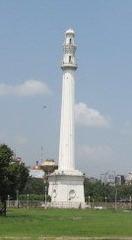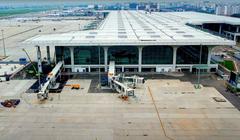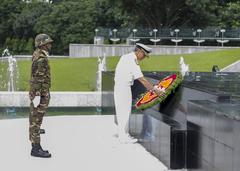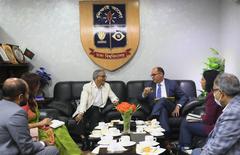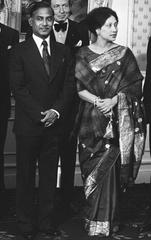
Faculty of Fine Arts University of Dhaka: Visitor Guide, Hours, Tickets, and Cultural Insights
Date: 04/07/2025
Introduction
The Faculty of Fine Arts at the University of Dhaka is a cornerstone of Bangladesh’s artistic and cultural landscape. Established in 1948 by visionaries including Shilpacharya Zainul Abedin, it was the first formal art institution in the region, fostering a distinctly Bengali modernism and serving as a vibrant center for education, cultural events, and national celebrations (Muzharul Islam Foundation; fineart-du.com). Architecturally celebrated for its tropical modernism, the campus also plays a pivotal role in Dhaka’s annual festivities such as the UNESCO-recognized Pohela Boishakh Mongol Shobhajatra (Lonely Planet; BSS News).
This detailed guide covers the Faculty’s history, architectural significance, academic structure, cultural impact, and practical visitor information—ensuring an informed and enriching experience for all visitors.
Table of Contents
- Historical Overview and Cultural Significance
- Architectural Significance
- Academic Structure and Departments
- Cultural Activities and National Celebrations
- Visitor Information
- FAQ
- Conclusion
- References
Historical Overview and Cultural Significance
Founded as the Government Institute of Arts and Crafts in 1948, the Faculty of Fine Arts emerged amid a surge in national identity and cultural awakening. Led by Zainul Abedin and other pioneering artists, its mission was to nurture indigenous talent and promote a uniquely Bengali artistic vision (Muzharul Islam Foundation).
Throughout its history, the Faculty has been a nucleus for artistic innovation and political activism. During the Language Movement of 1952 and the Liberation War of 1971, students and faculty produced powerful protest art, posters, and banners, contributing to Bangladesh’s independence movement (The Daily Star). Today, its alumni include leading national and international artists, and the institution’s influence permeates contemporary Bangladeshi visual culture.
Architectural Significance
Design Philosophy and Features
Architect Muzharul Islam, regarded as the pioneer of modern Bangladeshi architecture, designed the Faculty’s main building in the early 1950s. His approach harmonized modernist principles with traditional Bengali elements and responded sensitively to Dhaka’s tropical climate (UNESCO Tentative List).
Key features include:
- Preservation of Natural Landscape: The master plan retains existing trees, blending the structure into lush gardens.
- Climate-Responsive Elements: Wide verandahs, “jali” (lattice) screens, and open courtyards maximize airflow and natural light.
- Integration of Local Motifs: Use of local brick, wood, and patterns reflect Bengali vernacular traditions.
- Open, Community-Oriented Spaces: The layout draws from the rural “bagan bari” (house-in-a-garden) concept, fostering creativity and interaction.
Regional and Global Context
The Faculty building stands as an early and influential example of tropical modernism in South Asia. Its fusion of modern architecture and local context predates similar regional works by Charles Correa and Geoffrey Bawa, earning it a nomination for UNESCO World Heritage status (UNESCO Tentative List; ArchDaily).
Academic Structure and Departments
Curriculum and Admission
The Faculty offers Bachelor (BFA), Master (MFA), and postgraduate programs across eight departments, combining rigorous academic standards with creative exploration (fineart-du.com). Admission is competitive, requiring candidates to pass both written and practical entrance examinations. Application periods and requirements are published on the official website (du.ac.bd/faculty/FACFART).
Departments
- Drawing and Painting: Emphasizes both classical and contemporary techniques.
- Graphic Design: Focuses on branding, visual communication, and digital media.
- Printmaking: Covers etching, lithography, and screen printing.
- Sculpture: Encompasses 3D art, installations, and mixed media.
- Oriental Art: Highlights Asian art traditions and indigenous practices.
- Ceramics: Explores pottery and sculptural ceramics.
- Craft: Includes textiles, weaving, and embroidery.
- Art History: Offers theoretical and critical studies.
A strong faculty team of over 60 renowned artists and scholars ensures a dynamic learning environment (du.ac.bd/facultyVariousInfo/FACFART?type=description_en).
Faculty and Research
The Faculty is led by Dean Professor Dr. Azharul Islam Sheikh. It hosts regular workshops, research seminars, and exhibitions, and maintains an active alumni network to support student development and international collaboration (fineart-du.com).
Cultural Activities and National Celebrations
The campus is the epicenter for major national events, most notably Pohela Boishakh (Bengali New Year). The Mongol Shobhajatra, created by faculty and students, features giant papier-mâché masks and vibrant floats—an event recognized by UNESCO as Intangible Cultural Heritage (Lonely Planet; Trip.com Moments). Regular exhibitions, student art shows, and the annual Zainul Utsab further highlight the Faculty’s cultural leadership (BSS News).
Visitor Information
Visiting Hours and Tickets
- Hours: Typically open Sunday to Thursday, 9:00 AM–5:00 PM; closed Fridays and public holidays. Some galleries may operate extended hours (e.g., 11:00 AM–7:00 PM). Always check the official website for current schedules.
- Tickets: Entry to the campus and exhibitions is generally free. Special events and guided tours may require advance booking or a nominal fee.
Accessibility and Facilities
- Location: Ramna, Dhaka—centrally located and accessible by public transport, taxi, or ride-sharing.
- Facilities: Wheelchair access, ramps, restrooms, shaded outdoor seating, and small cafes.
- Photography: Permitted in most outdoor and gallery spaces; restrictions may apply during certain exhibitions.
Guided Tours and Special Events
Guided tours are offered by appointment or during major festivals. These provide in-depth insights into the Faculty’s history, architecture, and art collections. Check the event calendar or contact administration for details (fineart-du.com).
Travel Tips and Nearby Attractions
- Footwear: Comfortable shoes are recommended for exploring gardens and walkways.
- Nearby Attractions: Combine your visit with Curzon Hall, Ramna Park, the National Museum, and other Dhaka landmarks for a full cultural itinerary (Nijhoom).
FAQ
Q: Are there entrance fees to visit the Faculty of Fine Arts?
A: No, entry is usually free; some special exhibitions or tours may require tickets.
Q: What are the best times to visit?
A: The campus is lively year-round, especially during Pohela Boishakh and other festivals.
Q: Is the campus accessible for people with disabilities?
A: Yes, with ramps and accessible facilities available.
Q: Can I take photographs?
A: Photography is generally permitted, but always ask before photographing people or in restricted areas.
Q: How do I arrange a guided tour?
A: Contact the Faculty in advance or check the website for tour schedules.
Conclusion
The Faculty of Fine Arts at the University of Dhaka is more than just an educational institution—it is a living testament to Bangladesh’s artistic spirit, architectural innovation, and cultural resilience. Whether you are a prospective student, art lover, or traveler, the campus offers inspiring galleries, striking architecture, and vibrant cultural events. For the best experience, check visiting hours in advance, explore during a festival, and immerse yourself in Bangladesh’s creative heartbeat.
Stay connected with the Faculty via their official website and social media, and consider downloading the Audiala app for exclusive visitor guides and cultural insights.
References
- Muzharul Islam Foundation
- ASEF Culture360 - Faculty of Fine Arts University of Dhaka
- Faculty of Fine Arts Official Website
- BSS News
- UNESCO Tentative List
- The Daily Star
- ArchDaily
- Trip.com Moments
- Lonely Planet
- Nijhoom - Dhaka Tourist Attractions

